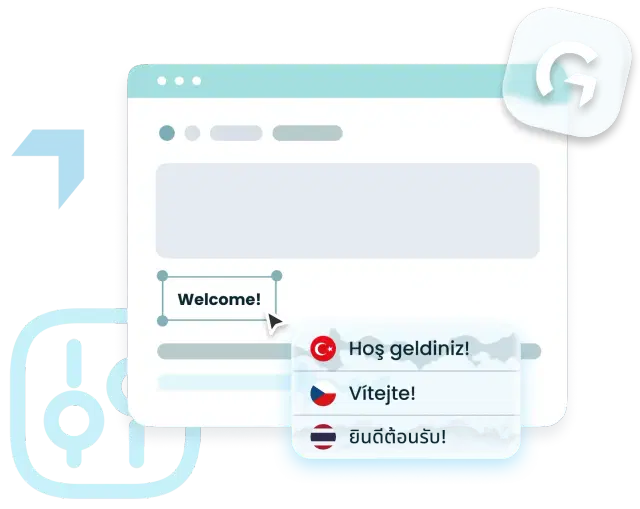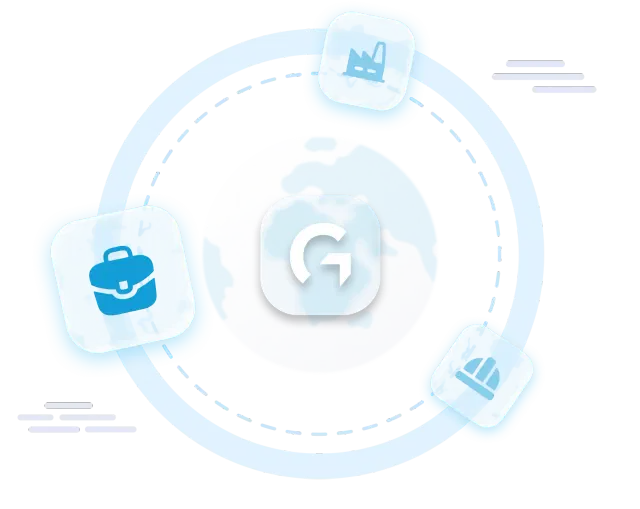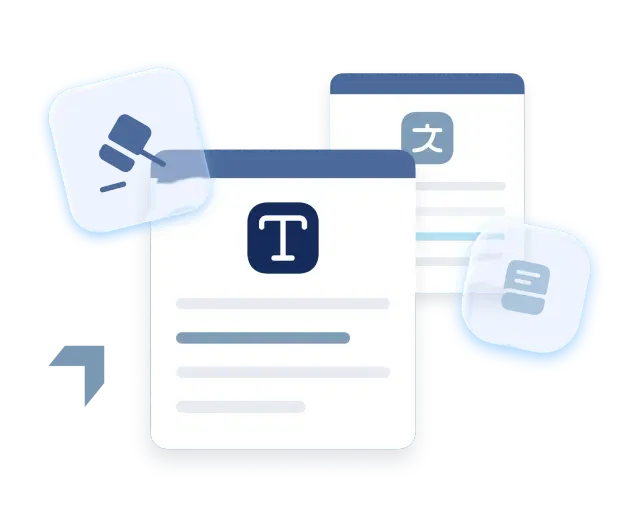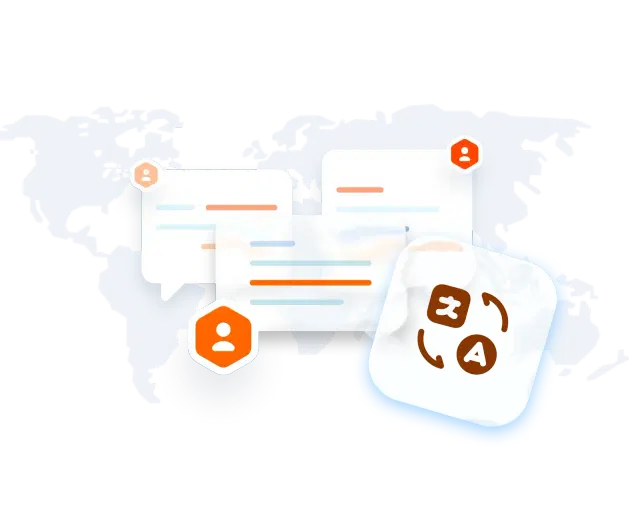The 2024 Machine Language Translation Guide
Machine Language Translation Guide | Top Software and Key Features
Updated on September 17, 2025
Machine Language Translation Guide | Top Software and Key Features
Businesses today operate in a multilingual world, whether expanding internationally or serving diverse communities locally. Communicating across languages is no longer optional—it’s essential. Machine translation (MT) software enables businesses to translate text automatically using advanced algorithms and artificial intelligence (AI) to streamline global communication.
Over the years, MT has evolved from rigid rule-based systems to neural machine translation (NMT), which uses deep learning to improve accuracy and natural language flow. Companies now rely on machine translation software to translate high volumes of content quickly, from product descriptions to customer support interactions.
This machine language translation guide covers:
- The evolution of machine translation, from early rule-based models to AI-driven neural translation.
- The business case for MT, including cost savings, speed, and market expansion.
- A comparison of top machine translation software, including neural machine translation tools.
- Key factors in choosing the right MT solution, such as accuracy, scalability, and integration.
Understanding how MT works—and selecting the right tool—can help businesses reduce costs, improve efficiency, and reach a global audience with confidence.
The Evolution of Machine Translation
Machine translation has undergone significant advancements, evolving from basic rule-based systems to modern neural machine translation (NMT) driven by artificial intelligence. Here’s how the technology has progressed:
Rule-Based Machine Translation (RBMT): The Early Days
Developed in the 1970s, rule-based machine translation (RBMT) relied on predefined linguistic rules and dictionaries to translate text. These systems translated word-for-word with strict adherence to grammatical structures. While innovative at the time, RBMT struggled with fluency and context, often producing rigid, unnatural translations.
Statistical Machine Translation (SMT): The Shift to Data-Driven Models
By the 1990s and early 2000s, statistical machine translation (SMT) replaced rule-based methods. Instead of relying on pre-programmed rules, SMT analyzed vast bilingual datasets to predict translations. This approach improved accuracy but still lacked true linguistic understanding, often missing nuances and contextual meaning.
Neural Machine Translation (NMT): The AI Revolution
In 2016, the introduction of neural machine translation (NMT) transformed the field. Unlike previous models, NMT uses deep learning and artificial neural networks to process entire sentences holistically rather than word-by-word. This results in:
- More natural, context-aware translations
- Better fluency and readability
- Continuous learning from multilingual data
Leading tech companies like Google, DeepL, and Microsoft have integrated NMT into their machine translation software, significantly improving quality and usability.
Ongoing Innovation in Machine Translation
Machine translation continues to evolve with:
- Context-aware translation: improving accuracy for industry-specific and conversational language.
- Adaptive learning: where systems refine their output based on user feedback.
- AI-driven localization: considering cultural nuances and regional dialects.
While human translators remain essential for high-precision tasks, the latest neural machine translation software brings businesses closer to seamless global communication than ever before.
Looking to the Future
As we look to the future, the focus is on enhancing the adaptability and accuracy of NMT. Efforts are underway to refine these systems to understand cultural nuances, regional dialects, and industry-specific jargon. The integration of context-aware translation and the ability to learn from user feedback are areas of significant development. The future of machine translation is not just about translating words but conveying meanings, emotions, and cultural contexts, bridging linguistic gaps with ever-increasing finesse.

The Business Case for Machine Translation
MT is more than just a convenience—it’s a strategic tool for businesses looking to expand their reach, improve efficiency, and reduce costs. As companies operate in increasingly global markets, machine translation software enables seamless communication with international customers.
Revolutionizing Global Communication
The advent of machine translation (MT) has revolutionized the way businesses approach global communication and expansion. In a world where instant communication across borders is the norm, MT offers a practical, efficient solution to language barriers. Its impact on global business operations is profound, facilitating seamless interaction with diverse markets and customer bases.
Speed and Volume: A Game Changer
One of the most significant advantages of MT is its ability to handle large volumes of text at unprecedented speeds. This rapid translation capability is indispensable for businesses dealing with high volumes of content, such as user manuals, product descriptions, and customer service communications. With the continual advancements in machine learning algorithms, MT software is becoming even more efficient. It’s not just about translating millions of words; it’s about doing so accurately and in real-time, significantly reducing the time-to-market for products and services in international markets.
Enhanced Accessibility and Market Expansion
MT breaks down language barriers, making products and services accessible to a wider audience. This inclusivity is crucial in today’s global market, where consumers expect and appreciate content in their native language. Research shows that consumers are significantly more likely to purchase from websites and platforms that cater to their language preferences. MT, therefore, becomes a vital tool in localizing content, enhancing customer experience, and ultimately, driving international growth.
Cost-Effectiveness: Reducing the Bottom Line
Cost reduction is another critical aspect of the business case for MT. By automating the initial stages of the translation process, MT reduces the need for extensive human intervention, thereby cutting down on translation costs. While human translators are essential for ensuring quality, particularly in nuanced or specialized content, MT serves as an effective starting point, handling the bulk of the work and allowing human translators to focus on refinement and localization. This hybrid approach of machine and human translation offers a balance between cost efficiency and quality assurance.
Streamlining Workflows and Integration
Modern MT software is designed to integrate seamlessly with various business tools and platforms, from content management systems to e-commerce platforms. This integration streamlines translation workflows, making it easier for businesses to manage and update multilingual content. By automating and simplifying the translation process, businesses can allocate resources more effectively, focusing on core activities and strategic growth.
Leading Machine Translation Software Options
There’s a wide array of MT software available, each with unique strengths. Some notable ones include:
Google Translate: The Ubiquitous Leader
Google Translate is perhaps the most recognized name in machine translation. Launched in 2006, it initially used statistical machine translation (SMT) but has since shifted to neural machine translation (NMT), dramatically improving translation quality. Its Google Neural Machine Translation (GNMT) system translates entire sentences, considering context for more accurate results. Its extensive language support and integration with various Google services make it a go-to tool for casual and business users alike.

DeepL Translator: The Precision Expert
DeepL Translator, developed by DeepL GmbH, focuses on delivering precise and nuanced translations. Launched in 2017, it is renowned for its high-quality translations, outperforming many competitors in head-to-head comparisons. DeepL’s strength lies in its advanced deep learning technology, which continually evolves by analyzing reliable linguistic sources. This software is particularly favored for translations that require a higher degree of accuracy and subtlety, such as literary or technical documents.

Bing Microsoft Translator: The Contextual Innovator
Bing Microsoft Translator, a product of Microsoft’s extensive research in machine translation, utilizes the latest NMT technology. It stands out for its attention to contextual translation, using an algorithm that considers word order for more accurate and natural translations. This software is part of Microsoft’s suite of tools, making it a convenient choice for businesses already within the Microsoft ecosystem, seeking seamless integration with other Microsoft services.

SYSTRAN Translate: The Industry Pioneer
SYSTRAN, founded in 1968, is one of the earliest entrants into the machine translation market. It has consistently updated its offerings with cutting-edge technology, currently using a pure neural machine translation (PNMT) engine. This approach models the entire translation process through an artificial neural network, resulting in highly accurate translations. SYSTRAN is particularly well-suited for businesses that require reliable translations across a variety of professional domains.

Amazon Translate: The Customizable Solution
Amazon Translate is part of Amazon Web Services (AWS) and offers fast, high-quality translations. A standout feature of Amazon Translate is its Active Custom Translation, which allows users to import their own translation data for personalized translations. This feature is particularly useful for businesses needing translations that align closely with their specific terminology and style.
Additional Considerations
When evaluating these leading MT software options, it’s important to consider specific features like language pairs, ease of integration, customization options, and the level of accuracy required for your translation needs. Each tool has its unique strengths and may be better suited for certain types of content or business requirements
The Importance of Website Translation
Broadening Market Reach
Website translation is no longer just a tool for global reach; it’s also crucial for tapping into diverse language markets within local regions. Many urban areas are linguistic melting pots, housing significant populations that speak different languages. By translating a website into these languages, businesses can connect more deeply with these communities, expanding their local customer base. This approach not only demonstrates cultural sensitivity but also addresses a market segment that competitors might overlook.

Enhancing User Experience and Trust
Translating a website into multiple languages significantly enhances user experience. Customers are more likely to engage with a website and make purchases if the content is in their native language. This familiarity breeds trust and loyalty, leading to higher conversion rates and repeat business. By providing information in multiple languages, businesses show respect for cultural diversity, which resonates positively with customers.
Compliance with National Laws and Regulations
In some regions, website translation is not just beneficial but also a legal requirement. For instance, Quebec’s Bill 96 mandates the use of the French language in various aspects of public life, including business operations. Ensuring that your website is available in French can be crucial for compliance with such laws. This not only avoids potential legal issues but also shows a commitment to respecting and valuing the local culture and language, which can further enhance a brand’s image.
SEO Benefits
Multilingual websites have a significant advantage in terms of search engine optimization (SEO). By offering content in multiple languages, businesses can rank in search results across different linguistic markets. This not only increases visibility but also drives more organic traffic to the website. Moreover, search engines often favor websites that provide content in the user’s native language, leading to better search rankings and increased visibility.
Selecting the Right Machine Translation Tool
Assessing Your Specific Translation Needs
Before selecting a machine translation (MT) tool, it’s crucial to understand your specific translation requirements. Different tools have varying strengths, such as technical precision or colloquial fluency. For instance, a business needing to translate technical documents will have different requirements compared to one translating marketing content.
User Interface and Integration Capabilities
Ease of use is a significant factor. A user-friendly interface reduces the learning curve and increases efficiency. Additionally, the tool’s ability to integrate with existing systems, like content management or e-commerce platforms, is vital for streamlined operations.
Cost-Effectiveness and Budget Considerations
Budget plays a key role in the decision-making process. Some MT tools offer subscription-based models, while others may charge per word. Assessing the long-term cost implications is important, especially for businesses with large volumes of content to translate regularly.
Privacy and Data Security
In today’s digital age, data privacy and security are paramount. Review the provider’s privacy policy, especially if you handle sensitive or confidential information. Ensure the tool complies with your region’s data protection regulations.
Language Support and Accuracy
Consider the range of languages supported by the MT tool and its accuracy in each. Some tools might be more accurate in certain language pairs than others. Testing the tool with sample translations can provide insights into its effectiveness for your specific needs.
Customization and Scalability
Finally, consider whether the MT tool allows for customization, such as adding industry-specific terminology, and whether it can scale according to your business growth. A tool that adapts to your evolving needs will be a more sustainable choice in the long run
The Role of GlobalLink Web in Leveraging Machine Translation
While MT engines like Google Translate, DeepL, or Bing Microsoft Translator are crucial, they are just one piece of the puzzle. Our software tool plays a vital role in managing these translations on your website. It helps organize and maintain the structure and meaning of content when translating into multiple languages, and perhaps most importantly, deploying a multilingual website in just a few minutes without needing to hire a web developer.
GlobalLink Web allows you to utilize Machine Translation Engines that suit your needs, while allowing you to edit your translations truly in-context. See what your translated site looks like before you push live!
Frequently Asked Questions
What is Machine Translation (MT) Software?
Machine translation software automatically translates text from one language to another using algorithms. It’s an AI-based tool that has become essential for businesses engaging in international communication and commerce.
How Has Machine Translation Evolved?
Machine translation began with rule-based systems in the 1970s, evolved through statistical machine translation, and has now advanced to neural machine translation (NMT), which offers higher accuracy and more natural-sounding translations.
Why is Machine Translation Important for Businesses?
Machine translation helps businesses reach a global audience by breaking down language barriers, translating content quickly and efficiently, and reducing translation costs.
What are Some Leading Machine Translation Software Options?
Some notable options include Google Translate, DeepL Translator, Bing Microsoft Translator, SYSTRAN Translate, and Amazon Translate. Each has unique features and strengths.
How Do I Choose the Right Machine Translation Tool?
Consider factors like the tool’s capabilities, ease of use, cost, customer support, and privacy policies. The best choice depends on your specific translation requirements.
Can Machine Translation Replace Human Translators?
While machine translation has improved significantly, it is not meant to completely replace human translators. It serves as a starting point for translations, which can then be refined by human translators for accuracy and cultural relevance.
What Makes GlobalLink Web Essential for Website Translation?
GlobalLink Web helps organize and maintain the content’s structure and meaning across multiple languages, ensuring seamless integration of MT into your translation workflow. Deploy your MT Engine of choice in seconds.
How Does GlobalLink Web Integrate with Machine Translation Engines?
Our software integrates with various MT engines like Google Translate, DeepL, or Bing Microsoft Translator, combining their strengths and providing a comprehensive solution for managing website translations effectively. GlobalLink Web allows you to deploy your MT engine of choice without any coding needed.
Explore Our Solutions
About
We created GlobalLink because we believe that all businesses great and small should have a beautifully translated and localized website.





